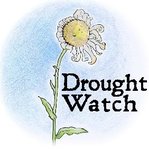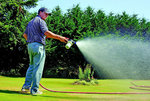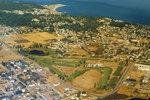No one at City Hall can remember the last time the City of Port Townsend instituted outdoor watering restrictions, as is being done now due to a drought emergency.
"The last time we had this …
This item is available in full to subscribers.
We have recently launched a new and improved website. To continue reading, you will need to either log into your subscriber account, or purchase a new subscription.
If you had an active account on our previous website, then you have an account here. Simply reset your password to regain access to your account.
If you did not have an account on our previous website, but are a current print subscriber, click here to set up your website account.
Otherwise, click here to view your options for subscribing.
* Having trouble? Call our circulation department at 360-385-2900, or email our support.
Please log in to continue |
|




No one at City Hall can remember the last time the City of Port Townsend instituted outdoor watering restrictions, as is being done now due to a drought emergency.
"The last time we had this situation was in 2002 and 2009 and we might have issued a warning. But we've never declared an emergency," said City Manager David Timmons Monday, Aug. 3, shortly before the Port Townsend City Council voted unanimously to approve a second drought contingency plan. The council passed Ordinance 3132, which is more aggressive than Ordinance 3131, approved July 20.
Effective immediately, the city is asking residents with street addresses ending in an even number to limit outdoor watering to even-numbered days of the month, and those with addresses ending in an odd number to water only on odd days.
"The practical side of this is we're just asking people to water every other day. But we're not going to be going down the street to check on people," Timmons said.
The immediate goal: Reduce the amount of water the city uses by 10 percent from what it normally would be this time of year.
"So if we were at 1.5 million, we'll want it down 10 percent of that," he said of the public water systems' average daily use. In the first stage, the city wants to save 150,000 gallons a day, he told the City Council.
Conservation measures apply to a long list of city-owned facilities, from the golf course, which is the top water user outside of the Port Townsend Paper Corp., to the City Hall lawn to various city parks and greenbelt areas.
There is no snowpack this year in the Olympic Mountains, and rivers that feed into the city's reservoirs are running low. Lords Lake reservoir is typically used starting in September and not July, as is now the case.
That's why the city has declared not only a water emergency but a fire-hazard emergency as well. Typically, late August and September are when river water flow become a problem. This year, the problem began in June. Rainfall is needed to help
rivers and reservoirs, and also to alleviate the extreme fire danger.
Timmons, in fact, said he's more worried about fire than water.
PAPER MILL
While Ordinance 3132 spells out new restrictions on city water customers - including the city itself - Timmons is quick to admit that the the biggest reduction in water consumption needs to come from the Port Townsend Paper Corp. The county's biggest private employer is also the biggest water consumer, due to the pulp process.
"People can reduce their use. They should do that as the normal course of everyday life to be good stewards," Timmons said. "But the real key factor here is mill consumption. To change the course of events, the mill has to change its consumption.
"It's not something we'll achieve by imposing it upon residents and it's where I think we need to be honest with the public," he noted.
The mill uses roughly 10 million gallons of water a day. This year, under new owners, the mill has added three water cooling towers in an effort to reuse as much water as it can.
In 2009, when the city last faced a water crisis and was drawing on Lords Lake, the mill did not modify its use as aggressively as it has this year, Timmons recalled.
"A [mill] shutdown. We skated that in 2009. They took a gamble it would rain. They didn't modify their operations like they are now," Timmons said.
Instead, the mill followed its annual closed-for-maintenance routine in October. And then it rained.
"If the rains had not come then, they wouldn't have been able to restart," Timmons said.
Technically, the city and the mill co-manage the water system and share liability should anything happen. The mill doesn't share its conservation plan with the city, a reality Timmons said is on the list of must-changes when the water agreement with the mill expires in 2020.
In the city's new emergency declaration, the mill is being asked to reduce consumption by 16.7 percent in Stage 1 and also submit a revised action plan to further reduce consumption. The mill would "cease production and limit water use to that essential for health and safety when Lords Lake is empty or if the volume of water reserved for municipal use is reached."
Timmons said there is a valve that controls mill water flow.
"But the problem that it raises is that by shutting off the system it would raise the pressure in the system where it may cause a rupture in the pipe," he said. For safety, Timmons said, mill officials estimate they need 1 to 2 million gallons of water day to run through the system so that there isn't negative pressure on the pipes.
Timmons also noted that the city and the mill have gotten water meters reconciled. He said there is a meter that the mill wasn't reading and one it was, which is why there was a discrepancy in how the city and mill measured mill water consumption.
A PT Paper official confirmed that fact last week, with the mill estimated to use about 10 million gallons a day. The goal, Timmons said, is to get that down to 8 million gallons a day.
TOP 25 USERS
While the mill is the top water consumer overall, the City of Port Townsend and many other public agencies are are well ahead of any single private water customer.
Top on the water-use list within the city is the Port Townsend Golf Club. It has a lease to manage the 49 acres of city-owned property. As part of the lease, the city foots the bill for golf course irrigation, which in June measured 2,808,000 gallons.
Gabriel Tonan, golf club manager and lessee, said Monday that in the last month, he's reduced water use by 30 percent.
"If I get rain, I just shut the system off," Tonan said. "I wish I had a little water for the fairways because the grass is starting to vanish, but I understand the drought situation."
Watering is continuing on the greens, which could be ruined without irrigation. "I'm being pretty sparing on the tees and everything else," Tonan noted.
The city has filed for a new water right with the state Department of Ecology to drill a well to serve the golf course and disconnect the golf course from city water. The city did that in 2002 and is still in line to get a water right, but that could take years.
"What we've asked for now is permission to put in a temporary emergency well and disconnect it from the system," Timmons said of a recent meeting with the state Department of Ecology and state Department of Health.
"We could do it under an emergency but if the emergency was lifted, we'd have to discontinue," Timmons said.
It's possible that the city could find grant funding to drill a golf course well and "that would drop the city's use dramatically," Timmons said.
He noted that it makes no sense to use potable water - water that's chlorinated - on the golf course.
Then there's Fort Worden, with the Fort Worden Public Development Authority controlling the campus with most of the buildings, and Washington State Parks still responsible for the campgrounds. Fort Worden is No. 2 on the city's list of water consumption at 872,000 gallons for the month of June. Not a lot of irrigation takes place at the park.
"It's always been suspected that there is a leak down in the lower campground," Timmons said. He said the city has leak-detection equipment and is working with the FWPDA and State Parks to follow through with that.
Likewise, the Port Townsend Food Co-op also showed up on one list as a large consumer, in spite of its low-flow toilets. Timmons said the city doesn't know why but does plan to check meter accuracy.
Other large water consumers in Port Townsend include the Port Townsend School District, which used 543,000 gallons in June, and Jefferson County Memorial Athletic Field, which used 502,000 gallons.
Jefferson Healthcare shows up twice on the Top 25 list: It is No. 4 using 448,000 gallons at one meter at 834 Sheridan St. and as No. 20 using 152,000 gallons at 830 Sheridan.
The Port of Port Townsend also shows up twice on the list - its port facility is No. 8 and its restroom/laundry facility is No. 24.
Other big public users include Washington State Ferries and the Fort Worden Military Cemetery, federal property managed through Joint Base Fort Lewis McChord.
Public Utility District 1 also buys water from the city to feed into Local Utility District No. 3, which has 320 connections in the Adelma Beach area 5 miles from PT. When a new well the PUD has drilled is approved, the Adelma Beach area gets switched off city water. For now, that system is No. 7 on the Top 25 list, using 334,300 gallons in June.
Big private customers include Life Care Centers of America, which operates a nursing home, the Port Townsend Motor Inn, Discovery View Retirement Apartments, Far Reaches Farm, Harborside Inn, Seaport Landing and Manresa Castle.
Jens Coppenrath, who Timmons said is starting a vineyard within the city, is No. 22 on the list, using 147,000 gallons of water, and John Barr is No. 25 on the list. Timmons said Barr is associated with a farm.
(Nicholas Johnson and, Robin Dudley contributed to this report.)
"To change the course of events, the mill has to change its consumption."
David Timmons city manager
Rivers still adding to city reservoir
For now, the City of Port Townsend has water.
Public Works Director Ken Clow reported that Lords Lake reservoir was at 36 feet, 8 inches as of Monday morning, Aug. 3, "which is actually pretty good." The city and Port Townsend Paper Corp. are drawing about half their water from the Big Quilcene River, he said, and about 500,000 gallons a day from the Little Quilcene River. The two Quilcene rivers are still supplying about 8 million gallons a day or about two-thirds of total demand, according to the city's website.
"City water use averaged 1,351,000 gallons [per day] over [the] past seven days, 666,000 gallons less than the previous week. However, water use is on the upswing with the warmer weather over the past few days," the website noted.
Top 25 water users in Port Townsend
The Port Townsend Paper Corp. mill uses an estimated 10 million gallons a day, with conservation, while all other city water consumers combined use about 1.5 million gallons a day during the summer.
The list below shows the City of Port Townsend water system's top 25 users, ranked by the number of actual gallons billed in June 2015.
This list does not include the paper mill's water use.
City of Port Townsend, golf course irrigation - 2,808,000
Fort Worden Public Development Authority - 872,000
Port Townsend School District - 543,000
Jefferson County, Memorial Athletic Field - 502,000
Jefferson Healthcare hospital, 834 Sheridan St. - 448,000
Life Care Centers of America care facility - 381,000
PUD No. 1 for LUD No. 3 - 334,300
Port of Port Townsend - 293,000
Port Townsend Motor Inn, motel - 261,000
Discovery View Retirement, irrigation - 253,000
City of Port Townsend, Chetzemoka Park - 235,000
Sue Milliken, Far Reaches Farm - 203,000
Fort Worden Military Cemetery - 192,000
Discovery View Apartments - 186,000
Assisted Living Concepts (Victoria Place) - 181,000
Harborside Inn, motel - 177,000
City of Port Townsend, City Hall - 170,000
Washington State Ferries - 160,000
Seaport Landing, senior apartments - 158,000
Jefferson Healthcare, 830 Sheridan St. - 152,000
Freeland Investments Inc. (Manresa Castle) - 150,000
Jens Coppenrath, 3405 Jackman St. - 147,000
Mountain West Seaport Landing, senior living - 146,000
Port of Port Townsend, restroom/laundry - 139,000
John Barr, 3325 McNeill St. - 136,000
• Source: City of Port Townsend records for June 2015. Addresses listed may be the billing address only.